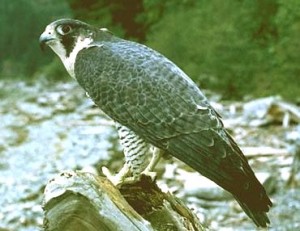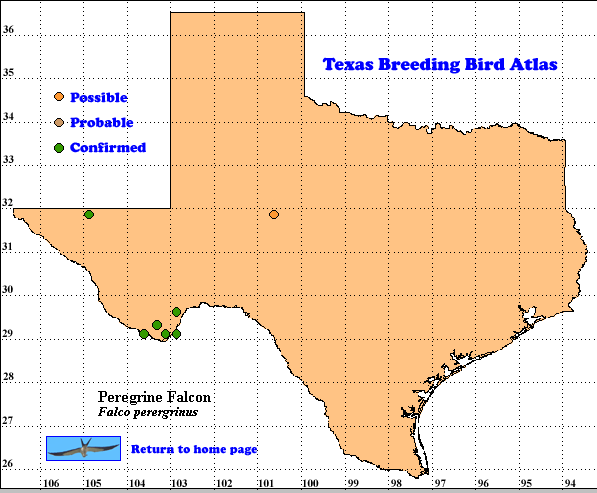The Peregrine Falcon once ranged throughout much of North America, from the boreal forests of Alaska and Canada south to Mexico. The subspecies breeding in Texas is F. p. anatum.
Populations suffered a dramatic decline when the use of DDT became widespread after World War II. Research indicated that DDT and other organochlorine pesticides were causing Peregrine Falcons to lay thin-shelled eggs that broke during normal incubation. The impact of organochlorine pesticides was most profound in the eastern United States and southeastern Canada where where the peregrine was virtually eliminated from the wild. The Peregrine Falcon was listed by the United States Fish and Wildlife Service (USFWS) as endangered in the Federal Register on 13 October 1970 and in the Endangered Species Act in 1973. Through the reintroduction of captive-bred birds peregrines are now reestablished in much of their former range (USFWS, 1993). F. p. anatum was delisted in 1999 (White et al. 2002).
DISTRIBUTION. There are three subspecies of Peregrine Falcon within North America: F. p. tundrius found in the Arctic tundra of North America and Greenland; F. p. anatum North America south of the tundra to north Mexico except Pacific Northwest; and F. p. pealei found from Washington north through western Alaska (White et al., 2002). In Texas TBBAP atlasers found resident populations of anatum in the rugged mountains of the Trans-Pecos and canyons of the Rio Grande with 3 confirmed breeding records each in latilongs 29102 and 29103 and 4 confirmed breeding records and 1 probable in 31104. The one possible record in 31100 may be a transient bird.
SEASONAL OCCURRENCE. In the Trans-Pecos area of Texas the Peregrine Falcon has a relatively long breeding season beginning in February with courtship. Egg laying may occur in March or April and fledging of young usually takes place mid-May to mid-July. Peregrines at higher elevations tend to nest a bit earlier than birds at lower elevations (McKinney 1987).
Migrant Peregrine Falcons (F. p anatum and/or tundrius) are seen throughout the state. Fall migrants may be seen as early as mid-July and spring migrants may linger as late as early May. Tundrius is a locally uncommon winter resident in the Coastal Prairie especially near bays and estuaries and rare to very rare winter resident, primarily in urban areas, inland to north-central Texas.(Lockwood and Freeman 2004).
BREEDING HABITAT. Peregrine Falcons prefer to nest on very tall sheer cliff faces with a commanding view, a nearby water source and a good prey base. The breeding population in Texas is located in the remote wild canyons of the Rio Grande up into pine-oak woodlands in the Big Bend and Guadalupe Mountains national parks. They are avian predators and take their prey in the air. Preferred prey in western Texas consists of White-winged (Zenaida asiatica) and Mourning (Z. macroura) doves with songbirds making up the balance. Occasionally they take bats. (Sharp 1984)
The male Peregrine Falcon chooses the nest site or “scrape”, a hollowed out depression he makes in substrate in a hole or overhang on a cliff face. Peregrines do not build a nest but occasionally will use an old stick nest formerly occupied by a raven or another hawk (Ratcliffe 1980). As egg laying approaches the female becomes lethargic and sits quietly for long periods of time. The four eggs (range 3-5), about the size of a chicken egg. are laid one every other day; they are smooth or finely grained, creamy white or whitish pink that is nearly concealed by bright reddish brown spots and blotches (Harrison, 1979). Incubation lasts 28 to 32 days; chicks grow rapidly and fledge around 38 to 44 days. Reproductive success of a pair is counted only after the young have actually flown from the scrape (McKinney 1994).
STATUS. Lockwood and Freeman (2002) describe Peregrine Falcon (F. p. anatum) as a very local summer resident with breeding confirmed in the Guadalupe and Chisos mountains and the cliffs along the Rio Grande in southern Brewster County north to Presidio County (Lockwood and Freeman 2002).
TBBAP surveys (1987-1992) show an increase in peregrine eyrie numbers in the Big Bend region since the 1970s but the Davis Mountain eyries remain empty and there is only one pair of peregrines in the Guadalupe Mountains (BRM 1994-95).
The status of the Peregrine Falcon in Texas is poor and declining. Reproductive failure is a common occurrence with reproductive rates showing sharp declines in 1994 and 1995. Recruitment rate is very slow, sometimes taking years to replace lost mates. With only 2 young fledged from 18 monitored sites in 1995 the population is not producing enough young to offset natural mortality.
Text by Bonnie Reynolds McKinney (Updated 2005)
Literature cited.
Harrison, H. H. 1979. A field guide to western birds’ nests. Houghton Mifflin, Boston, MA.
Lockwood, M. W. and B. Freeman. 2004. The TOS handbook of Texas birds. Texas A&M University Press, College Station.
McKinney, B. R. 1994. Black Gap Wildlife Management Area Peregrine Falcon 1994 field season survey. Technical report, non-game and urban wildlife program, Texas Parks and Wildlife Department, Austin. WNBGBK-STATE and OES, USFWS, Albuquerque, NM.
Oberholser, H. C. 1974. The bird life of Texas, Vol. 1. University of Texas Press, Austin.
Ratcliffe, D. A. 1980. The peregrine falcon. Buteo Books, Vermilion, SD.
Sharp, D. 1984. Peregrine falcon breeding status in Big Bend National Park. Rept. to USFWS, Albuquerque, NM, and Big Bend National Park, TX.
White, C. M., N. J. Clum,.T. J. Cade, and W. G. Hunt. 2002. Peregrine Falcon (Falco peregrinus) In The Birds of North America, No.6610 (A. Poole and F. Gill, eds.). The Birds of North America, Inc., Philadelphia, PA.

